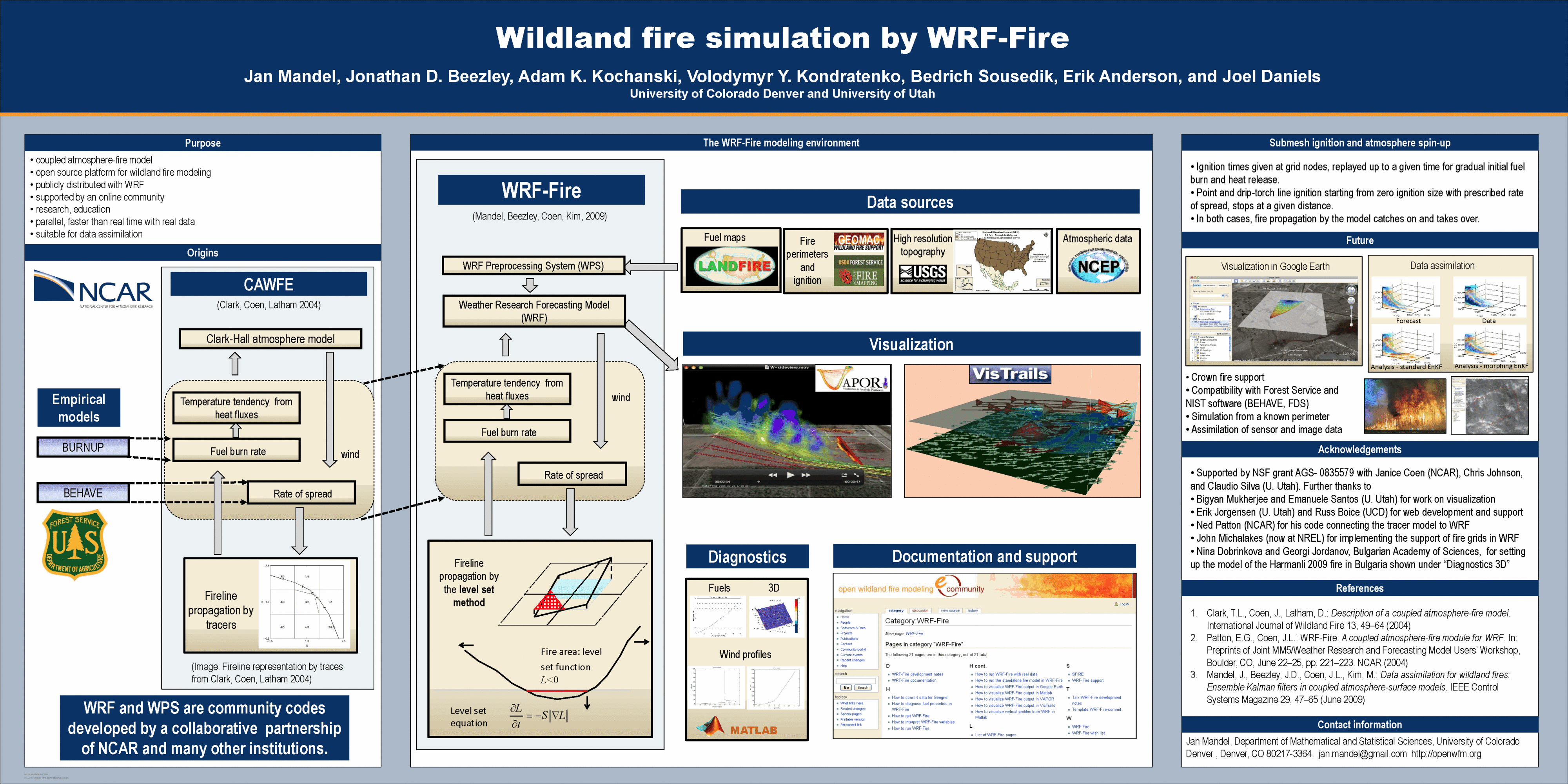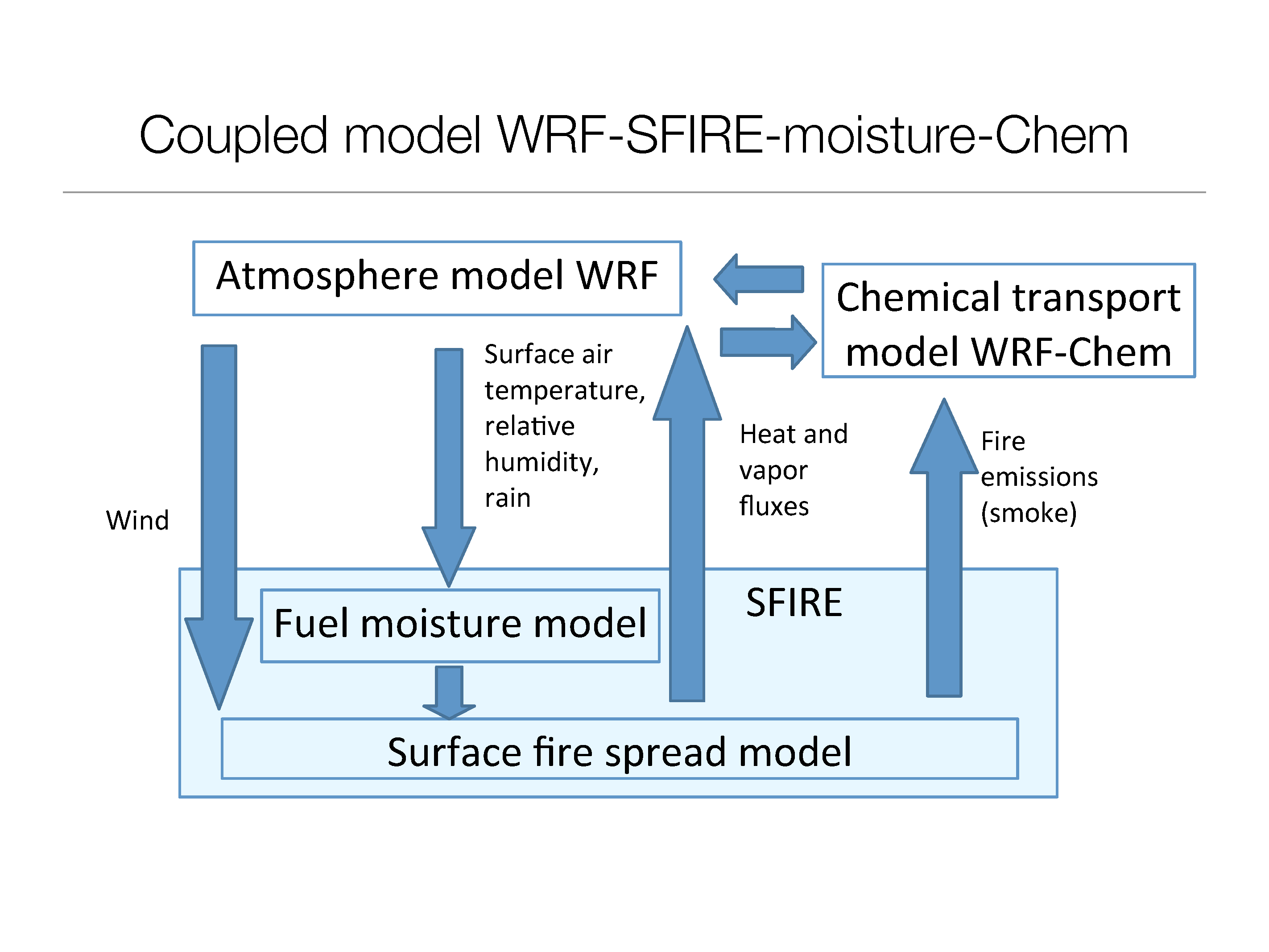Difference between revisions of "WRF-Fire"
({{historical}}) |
|||
| Line 1: | Line 1: | ||
| − | + | {{historical}} | |
{{software}} | {{software}} | ||
: ''The code under continued development in our repository and mirrors [http://repo.or.cz/git-browser/by-commit.html?r=wrffire.git] [https://github.com/jbeezley/wrf-fire/] is called '''[[SFIRE]]''', and the coupled code is called [[WRF]] and [[SFIRE]]. We reserve the designation [[WRF-Fire]] for the [[fire code in WRF release|version released with WRF]].'' | : ''The code under continued development in our repository and mirrors [http://repo.or.cz/git-browser/by-commit.html?r=wrffire.git] [https://github.com/jbeezley/wrf-fire/] is called '''[[SFIRE]]''', and the coupled code is called [[WRF]] and [[SFIRE]]. We reserve the designation [[WRF-Fire]] for the [[fire code in WRF release|version released with WRF]].'' | ||
Revision as of 01:40, 15 July 2020
- This is an archived historical WRF-Fire/WRF-SFIRE page. Please go to [[{{{1}}}]] for the current software version.
- This is a page with basic information about a software. Please see Template for creating software pages for what should be here.
- The code under continued development in our repository and mirrors [1] [2] is called SFIRE, and the coupled code is called WRF and SFIRE. We reserve the designation WRF-Fire for the version released with WRF.
WRF-Fire combines the Weather Research and Forecasting model (WRF) with a fire code implementing a surface fire behavior model, called SFIRE, based on semi-empirical formulas calculate the rate of spread of the fire line (the interface between burning and unignited fuel) based on fuel properties, wind velocities from WRF, and terrain slope. The fire spread is implemented by the level set method. The heat release from the fire line as well as post-frontal heat release feeds back into WRF dynamics, affecting the simulated weather in the vicinity of the fire. The fire code is written in Fortran 90 following WRF coding conventions. It is integrated as a physics option, called from WRF as a subroutine. It calls WRF libraries for utilities such as I/O and communication between MPI processes. The fire code executes on a part of the domain, called a tile (in WRF nomenclature). All communication between the tiles is in the caller; thus, one time step requires multiple calls to WRF-Fire.
WRF-Fire is essentially a reimplementation of CAWFE with the weather model replaced by WRF and with the fire spread implemented by the level set method in SFIRE. The subroutines for the computation of the rate of spread and for the insertion of the heat flux to the atmosphere are taken from CAWFE. Click on the following images for the origins and a summary of current capabilities of WRF-Fire:
Distribution
WRF-Fire is public domain software, released under the WRF public domain notice and disclaimer.
The development version is called SFIRE; further information and links to downloads are in the Users' Guide. We'll be happy to consider additional features. A restricted version is available in WRF releases.
Contact
- Janice Coen (WRF release version), Jonathan Beezley or Jan Mandel (development version)
File format
All input, output, and restart files (with the complete model state) are in NetCDF format.
Programming language and environments
Fortran 90 with CPP preprocessor. Part of the WRF code is generated by C programs from a description in the registry.
Documentation
Technical description
- The algorithms and software structure of WRF-Fire are described in Jan Mandel, Jonathan D. Beezley, and Adam K. Kochanski, Coupled atmosphere-wildland fire modeling with WRF-Fire version 3.3, Geoscientific Model Development Discussions (GMDD) 4, 497-545, 2011. doi:10.5194/gmdd-4-497-2011. Current version is maintained at arXiv:1102.1343. An older version is in the sections Fireline propagation model and Level set-based wildland file model of Jan Mandel, Jonathan D. Beezley, Janice L. Coen, Minjeong Kim, Data Assimilation for Wildland Fires: Ensemble Kalman filters in coupled atmosphere-surface models, IEEE Control Systems Magazine 29, Issue 3, June 2009, 47-65. Preprint at arXiv:0712.3965, December 2007.
User's guides
- Users guide, updated continuously with SFIRE the software as distributed by the developers. The guide consists of selected pages from this wiki.
- The WRF-Fire pages on this wiki, updated continuously.
- The WRF-Fire chapter in the WRF 3 User's guide for the version in the WRF release.
Support
Mailing list
Questions and suggestions can be sent to the maling list at http://mailman.ucar.edu/mailman/listinfo/wrf-fire. Please subscribe to this list for further support, announcements, questions, and discussions.
Email support for SFIRE
When you write us, please:
- Make sure you test the issue first on the code exactly as you have received it from the repository as described in How to get WRF-Fire
git diffshould return no output, meaning that you have not modified any files- Send us the output of the command
git log | head -3to identify the version - Verify that you are on the latest commit on the master branch from the repository
- Recompile the code from scratch after typing
clean -afirst - Send us sufficient information to identify and reproduce the problem if needed (output of wrf compilation, namelist.input, output from the run, wrfinput file for a small test problem)
Email support for code in WRF release
The version of WRF-Fire in the WRF download is supported by NCAR. Please contact wrfhelp@ucar.edu with any questions regarding the version of WRF-Fire in the WRF release.
Wiki
We welcome contributions and discussion on the pages of this wiki. Please see the Main Page for How to get an account.
- The WRF-Fire wish list and Talk:WRF-Fire wish list are intended for further discussions regarding future developments of WRF-Fire.
- See the list of WRF-Fire pages for many quick guides how to do useful things, such as diagnostics and visualization
Publications
Contributors
- Janice Coen (NCAR) developed the physics components of the fire model in CAWFE (Coen (2005) and Clark et al. (2004)), in particular the fire spread rate and the heat flux insertion modules, which were adopted into WRF-Fire with no substantial changes, and has been refining the fuel and spread rate models.
- Ned Patton (NCAR) ported the fire code from (Clark et al., 2004) and interfaced it with WRF (Patton and Coen, 2004).
- Minjeong Kim and Jan Mandel (University of Colorado Denver) have identified a version of the level set metod suitable for fire spread, and developed a prototype Matlab code.
- Jan Mandel (University of Colorado Denver) has been developing the level set code and the overall fire module software structure.
- John Michalakes (formerly NCAR, now NREL) modified WRF to support refined grids (submesh) for the fire code.
- Jonathan Beezley (University of Colorado Denver) has further modified WRF to support the fire software, provided the software engineering infrastructure, has set up and maintains the git repository, maintains synchronization with WRF changes, and has been developing the modified version of WPS for WRF with the fire model to enable the use of real data.
- Volodymyr Kondratenko (University of Colorado Denver) has improved memory handing in the computation of remaining fuel.
- Adam Kochanski (University of Utah) has contributed variable atmospheric bubble initialization and suggested the walking line ignition. He is currently leading the validation effort.
- Kara Yedinak (Washington State University) has improved in fire initialization. See discussion
See also
- List of WRF-Fire pages
- WRF-Fire and SFIRE user's guide
- WRF-Fire development notes
- wikipedia:Wildfire modeling
- WRF-Fire at servinghistory.com
External links
- WRF users page with links to download and documentation
- WRF-ARW Users Guide v. 3.2 (direct link)
- Technical description of WRF-ARW v. 3 (direct link)
- Graph of the commits in the repository

